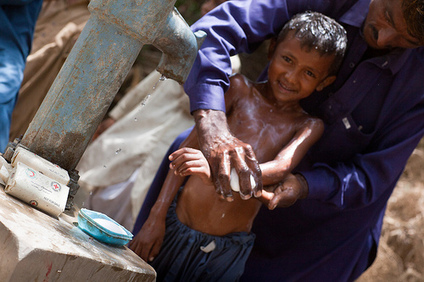What A Little Known, 12-Year-Old Public Health Success Says About Our Daily Happiness
Saving Lives in the Slums of Pakistan
Over four million people live in crowded slums on the outskirts of Karachi—the largest city in Pakistan. In the early 2000s, one in ten children living in these poor neighborhoods died before the age of five, mostly from diarrhea or acute respiratory infection.
But in 2005 Stephen Luby, a Nebraskan public health worker, implemented a simple public health initiative that dropped incidence of diarrhea 52%, pneumonia 48%, and skin infections by 35%.[1] That translates into a lot of saved lives.
The amazing thing is that Luby’s solution (a joint program sponsored by the U.S. Center for Disease Control, HOPE, a charitable organization in Pakistan, and Proctor & Gamble) did not change any of the deep, systemic problems that factored into the poor health conditions—virtually all drinking water was contaminated and sewage ran in the streets. To further complicate matters, widespread illiteracy made education difficult, corruption and political interests kept industries from employing these families, and even global agriculture prices that made rural farming life untenable.[2]
What was Dr. Luby’s trick?
And how can we apply to our own health?
Two Factors Contributed to the Success of The Karachi Health Soap Study
The Karachi initiative went like this: once a week, field-workers delivered soap throughout 25 randomly chosen neighborhoods (11 others were a control group). They instructed people to use the soap in six situations: during bathing, after defecation, after wiping a baby, before eating, prepping food, or feeding others. By the end of the study the households were using an average of 3.3 bars of soap per week.
What is so surprising about this program was that before it started, the households were already using two bars of soap per week!
Luby and his team determined that there were two major changes that resulted in the massive decrease in health complications. The first was economic—the increase in soap consumption did not cost the households anything. The second is what interests us most.
The Secret of Power Is How We Use What We Have
They changed people’s behaviors. Luby identified at least three specific ways this was accomplished.
1) Technique: Cleanliness is very important in South Asia—people more consistently wash their hands than the average American—but their handwashing technique before the program was poor enough to be ineffective. Sometimes they’d just wash one hand, other times they would use ash or mud instead of soap and water, and other times they wouldn’t wash for long enough.[3]
2) Timing / Frequency: Just as important, people were not used to washing before preparing food or feeding a child. Creating a mental checklist made handwashing during these critical times a regular part of their routine.
3) Enjoyment: The soap they received was more comfortable and smelled better than the soap they normally used. Plus they received the soap as a gift from field workers, instead of having a government mandate or someone wagging a finger at them.
What We Can Learn About Happiness From Pakistan
The purpose of this article is not to encourage everyone to wash their hands (although that is a valiant cause[4]).
The purpose is to find the underlying patterns of what works in enacting change and see how we can apply it to our own happiness, health, and the well-being of those around us.
First, we can recognize that like the citizens of the Karachi slums, we are probably facing a lot of barriers. But we do not have to address these head on to make massive improvements.
We already have some healthy habits—the results we seek can come from tweaking these (improving technique) and increasing their application (adjusting timing), particularly if we motivate ourselves from inspiration instead of guilt (enjoyment).
A Practical Suggestion For Stress Reduction
Let us look at an example: The goal of reducing daily stress by implementing a simple practice of deep breathing.
1) Technique
Most adults actually do not breathe deep into their diaphragms, which has all sorts of poor physical health results including shortness of breath. Use the following checklist to insure proper breathing technique:
- Are you breathing into your belly (instead of your chest)?
- Are letting your belly expand as your inhale, and deflate as you exhale?
- Are you inhaling through your nose?
- Can you count to five on the inhale, and five again on the exhale (instead of each breath taking second or less—you might have to build up to this)?
- Are your face, jaw, and other muscles relaxed (instead of tense)?
2) Timing / Frequency
How often do you remember to breathe deeply during the day? This technique will be most effective before and after stressful situations (just like handwashing is most effective before and after situations that expose us to bacteria). Consider using the following list of six activities that trigger you to remember to breathe deeply—or create your own.
- When you drink a cup of coffee
- When you get into your car and begin to drive, and when you are in traffic
- Every time you check Facebook
- When you use your credit card to pay for something
- While talking to an annoying co-worker or boss
- When your head touches the pillow, just before you go to sleep
Other options might include making meals, running late, communicating with a partner, parent, or child, when you look at your bank account or check your finances, after you realize you won’t have time to do everything you wanted to in a particular week, before a meeting, before a presentation, the first time you check email or voicemail—just make sure your list is between 5 and 9 items or it will be too easy to forget and will no longer be practical.
3) Enjoyment
Fortunately the physiological effects of deep breathing are likely to keep this practice a happy one. Thinking about it or judging yourself for not doing it are likely to increase stress, whereas actually doing it will succeed in your goal. If you are uncertain, limit yourself to thirty seconds, or five deep breaths to ensure that it never gets too unmanageable.
[1] Luby, Stephen P. Effect of handwashing on child health: a randomised controlled trial. Lancet 2005; 366: 9481-225 – 233. http://www.thelancet.com/journals/lancet/article/PIIS0140-6736(05)66912-7/abstract accessed 3/18/2014
[2] Gawande, Atul. The Checklist Manifesto. New York: Metropolitan Books, 2009. Print. (http://www.amazon.com/The-Checklist-Manifesto-Things-Right/dp/0312430000)
[3] Ibid.
[4] Proper Hand-Washing: Only 5 Percent Of Us Do It Right, Study Finds. Huffpost Healthy Living. 6/11/2013. http://www.huffingtonpost.com/2013/06/11/proper-hand-washing-clean-_n_3417401.html Accessed March 18th 2014.
Image:![]() All rights reserved by American Red Cross |
All rights reserved by American Red Cross |

